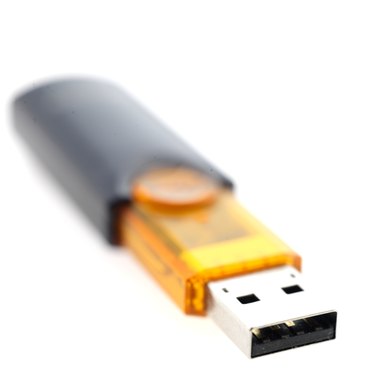
A universal serial bus (USB) flash drive is a small device that inserts into a USB port and provides a quick way to store a few gigabytes of information. USB flash drives continue to improve in technology, and some of the more advanced USB drives can hold the same amount of information as a small hard drive. These small, portable devices are convenient and affordable.
USB Connector
Video of the Day
The USB connector is the small, silver extension that extends from the main USB device. The connector is what inserts into the USB port of the computer. Because this part of the USB flash drive is easily damaged, newer USB flash drives come with a switch that pulls the connector into the main compartment. This avoids the problem of the connector melting, accumulating dust or being crushed. The USB connector inserts into any USB port in a computer, or the user can insert it into a hub for devices on a machine.
Video of the Day
Memory Chip
The flash memory chip, a black chip placed on the main circuit board of the USB drive, is what stores the information. This chip is protected by an outer case. These cases are sometimes clear, so the user can see the flash memory chip on the USB drive's circuit board. The flash memory chip contains different amounts of memory, depending on the device purchased. Flash drives started with a capacity of a few megabytes, but they continue to increase in capacity. Flash drives can hold gigabytes of information of flash memory chips.
LED and Crystal Oscillator
USB flash drives contain light-emitting diodes (LEDs). LEDs are lighted components that indicate processing or connection for the user. A green LED is used to mean "Ready." It indicates that the USB drive is connected and ready to save information. Some flash drives have a red LED light to indicate that an issue exists with the connection. A crystal oscillator is a small component on the flash drive's circuit board that sends a frequency signal. These oscillators are used in watches and other devices that keep time. Oscillators are used to control the output of the flash drive.